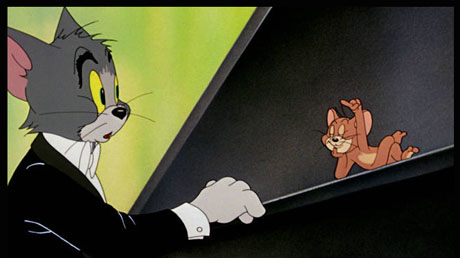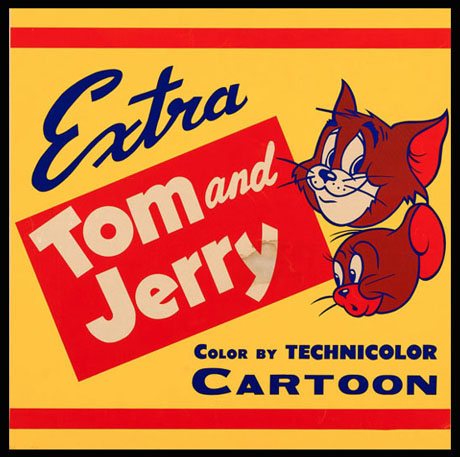
“Best of Enemies. Worst of Friends.”
This “tag line” on posters for the new live-action/animated movie Tom & Jerry, perfectly sums up the relationship the two have had since their debut almost 81 years ago.
The world-famous cartoon cat and mouse continue their prominent role in animation history with this new film, debuting this weekend in theaters and on the streaming service, HBO Max. The team’s latest return/refresh/reboot/re- “run” is the perfect opportunity to look back at their animated career by re-visiting some of their more popular films.

Puss Gets the Boot (1940)
The very first Tom & Jerry short at MGM set up their contentious relationship from the get-go with a simple story. After chasing Jerry, Tom is chastised by the maid, who informs him that she will throw him out of the house if he breaks one more thing. Jerry then proceeds to spend the rest of the short trying to get Tom in trouble.
The short would be co-directed by Rudolph Ising, along with William Hanna and Joseph Barbera. The latter two would go on to helm the characters’ films for the next eighteen years at the Studio and would use these films to launch their own animated empire.
Puss Gets the Boot features lush animation and a number of what would become standard sight gags, many of which would become pain points for Tom. There were some differences from later films, mainly in that Tom’s original name here was Jasper and that his design was of a different (almost kitten-like) appearance.
However, with Puss Gets The Boot, their rivalry was set and the chase was on.

Yankee Doodle Mouse (1943)
This was the first of the pair’s seven Academy Award wins and Yankee Doodle Mouse is not just significant for that, but also with being loaded with World War II-era patriotism, as Tom & Jerry battle each other in a basement. At one point, Jerry flies a box of lightbulbs like a fighter pilot, dropping the bulbs like “bombs” on Tom. As the short ends, Jerry holds up a sign that reads “send more cats” – a reference to the real-life Battle of Wake Island.
The short is such a product of its time that a gag involving ration stamps was actually removed when it was re-issued in 1950.

Anchors Aweigh (1945)
Talk about your iconic film moments! Gene Kelly’s dance with Jerry in this live-action feature has become a landmark, technical use of animation and live actors and one of the most famous sequences from the Golden Age of MGM Musicals. Eight years later, Tom & Jerry would return to live-action films to swim with Esther Williams in Dangerous When Wet.

The Cat Concerto (1946)
Another Academy Award winner, which was also recognized as one of the 50 Greatest Cartoons in Jerry Beck’s 1994 book of the same name. In the short, Tom is a tuxedo-clad classical pianist who battles with Jerry during a concert when the mouse turns up inside the piano.
What follows is a perfect Tom & Jerry chase, all of it set to Hungarian Rhapsody No. 2.
Author Will Friedwald writes in The 50 Greatest Cartoons: “The two protagonists revel in the opportunities for comic violence found in the mechanisms of the music-making process-parodying not only the hoity-toity manner of the concert virtuoso, but the hammers and strings of the piano itself.”

The Milky Waif (1949)
This short is significant for introducing Nibbles, a cute, little grey orphaned mouse who is left at Jerry’s doorstep, clad in a diaper and in need of milk. Jerry attempts to get this milk from Tom’s dish and the chase is on!
Nibbles became a recurring supporting player and made frequent appearance through the years and starred with Tom & Jerry in 1949’s The Little Orphan (which was remade as Feedin’ the Kiddie in 1957) and Safety Second (1950). In all, Nibbles appeared in thirteen Tom & Jerry shorts, including The Two Mousketeers (1952), 1953’s Two Little Indians (where he had an identical twin) and Touché, Pussy Cat! (1954), where he spoke.

Love That Pup (1949)
This short marked the debut of two other Tom & Jerry supporting players, the canine Dad and Son, Spike & Tyke. The father, Spike, whose voice was based on comedian Jimmy Durante had first made his debut in the 1942 Tom & Jerry short, Dog Trouble. It was with Love That Pup, however, that Spike and Tyke appeared for the first time together.
In the short, Tom runs afoul of Spike, while almost hurting Tyke as he chases Jerry. Tom soon finds himself with a new adversary in Spike.
Spike and Tyke were popular enough to garner their own spin-off series of cartoons shorts, which was short lived with only two.

Switchen Kitten (1961)
This Tom & Jerry short is significant in that it was the first produced after William Hanna and Joseph Barbera left MGM and the reigns were handed over to director Gene Deitch.
Deitch had come over from the UPA and Terrytoon Studios and brought with him a style that was more reminiscent of those Studios than MGM. This coupled with lower budgets resulted in animation that was nowhere near as full as the heyday of Tom & Jerry and this era of cartoons has come under criticism and is not fondly remembered by fans.

Pent-House Mouse (1963)
After a year of Gene Deitch, none other than Chuck Jones took over as director of the Tom & Jerry cartoons at MGM with this short subject.
Jones had recently been unfortunately fired from his home of many years, Warner Bros. and contracted his newly formed animation Studio, Sib Tower 12 Productions to produce brand new Tom & Jerry Cartoons.
Working with frequent collaborators, Abe Levitow, Michael Maltese and Ken Harris, this era of shorts (which ran from 1963-1967) bear the creative & quirky sense of humor that was a Jones hallmark at Warner Bros, as well as the distinctive animation found in his later TV Specials, like How The Grinch Stole Christmas.

The Tom & Jerry/Grape Ape Show (1975)
Things came full circle in 1975. After years of their classic shorts rerunning on TV, Tom & Jerry returned to Hanna-Barbera, now titans of TV animation, for this new Saturday Morning show that aired on ABC. It was filled with not only new Hanna-Barbera produced cartoons, but the show was “split” between Tom & Jerry shorts and those featuring a brand-new character, the Grape Ape, a forty-foot purple gorilla and his adventures with his sidekick Beagle Beagle.
This new Hanna-Barbera iteration ran through 1977 and started a recurring television resurgence for the characters that continued with The Tom & Jerry Comedy Show in 1980, which was produced by the Filmation Studio in 1980 and Tom & Jerry Kids (1990), which brought them back to Hanna-Barbera, now co-producing with Turner Entertainment Company.

Tom and Jerry: The Movie (1992)
The duo returned to film for their first fully animated feature. Taking a few pages from the “Disney book” of the era, the film is a musical and involves a plot in which Tom & Jerry help a young girl named Robyn escape her evil aunt.
Another game-changer with the film was that Tom & Jerry would speak, throughout the entire film, with actor Richard Kind as Tom and actress Dana Hill as Jerry.
The film opened internationally in 1992 and here in the states during the summer of ’93. Released by Miramax and directed by Phil Roman (with Joseph Barbera as “Creative Consultant”), the film was a box-office disappointment, but didn’t stop a litany of direct-to-video Tom & Jerry features that would follow.

And now, Tom & Jerry are back in a big-budget feature that combines live-action and animation and a cast that includes Chloe Grace Moretz, Michael Pena and Colin Jost. In the film, set at a New York City Hotel, the two start off as rivals, but must team up to help stop a “diabolical conspiracy.”
Will a new generation embrace Tom & Jerry? Well, after eight decades, Warner Bros is hoping that audiences will be ready to play another “game of cat and mouse!”

- An Eye for A Classic: The 60th Anniversary of “Mr. Magoo’s Christmas Carol” - December 22, 2022
- A Very Merry Mickey: The 70th Anniversary of “Pluto’s Christmas Tree” - December 19, 2022
- A Fine French Feline Film: The 60th Anniversary of “Gay Pur-ee” - December 12, 2022


 February 26th, 2021
February 26th, 2021  Michael Lyons
Michael Lyons  Posted in
Posted in  Tags:
Tags: 






